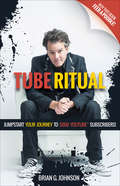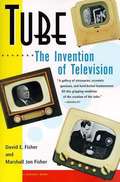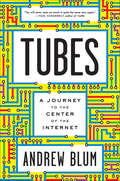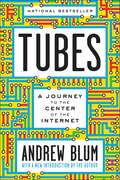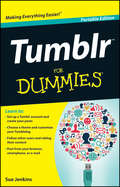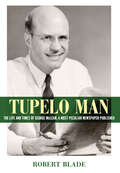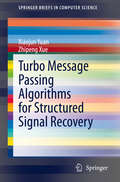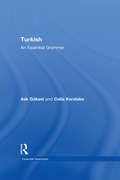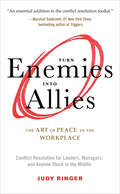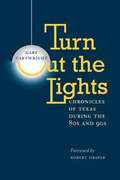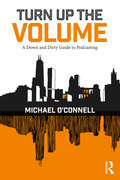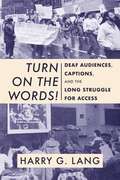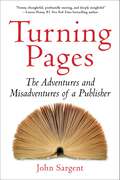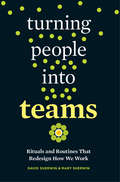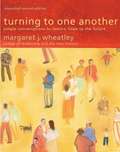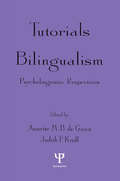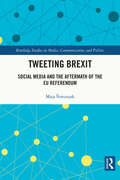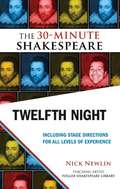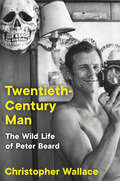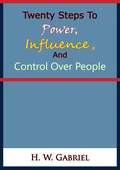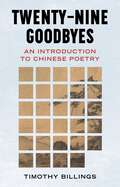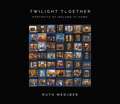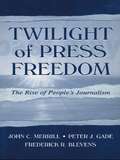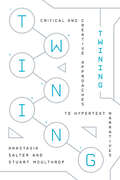- Table View
- List View
Tube Ritual: Jumpstart Your Journey to 5000 YouTube Subscribers
by Brian G. JohnsonEverybody begins their YouTube journey from zero.You have to start with no videos, views, or subscribers. Furthermore, more than 400 minutes of content is uploaded to YouTube each minute. To say that it&’s challenging to grow a channel is an understatement! In fact, less than 3% of YouTube channels ever gain more than 10,000 subscribers. Yet, in a one-year period, Brian G Johnson gained 10,623 subscribers and drove over half a million video views. Truly beginning from zero. Brian had no previous YouTube success to draw from and had to learn the myriad of camera settings, editing options, and technical details that often become a roadblock. Furthermore, he did it in a small and competitive niche, the YouTube video marketing niche.How, you ask?By researching, testing, and tweaking various video growth methods over a one-year period in order to identify why the YouTube algorithm promotes one video over another. Ultimately, this led to the creation of a video ritual based on his findings—a series of actions according to a prescribed order. More than a mere guide, Tube Ritual is a one-year case study with the goal being to drive more views and convert more viewers into subscribers. For those already creating videos or who want to in the future, Tube Ritual contains detailed, step-by-step information that plain works. From Branding to thumbnails, video structure, YouTube SEO, video calls to action, playlist strategies, channel strategies and more, Tube Ritual leaves no stone unturned.
Tube: The Invention of Television
by Marshall Jon Fisher David E. FisherThe colorful, definitive story of the inventors of television, the race for patents, and the vicious courtroom battles for markets. You're on Jeopardy, the category is popular science, and the answer is "In 1927 he transmitted the first image via an all-electronic TV system." If you don't know the question, you're not alone. In the half century since its commercial unveiling, television has become the undisputed master of communications media, revolutionizing the way postwar generations have viewed the world. Yet few know how television was created, who created it, or how it actually works. Tube is a riveting tale of technological and commercial adventure. Here is the story not of one mad scientist working alone in a laboratory but of a group of brilliant minds—iconoclasts with motivations that ranged from the idealistic zeal of invention to pure greed, each keeping an eye on the others in the race for fortune and glory. Here, too, is the progress of an invention—from laboratory prototypes that drew public laughter to the legal warfare for control of what would become an enormous market power. With devilish character sketches, compelling stories, and engaging, accessible scientific explanations, authors David E. Fisher and Marshall Jon Fisher take us through the advent of "living color" and beyond, concluding with a glance to the future of the medium and the impact of recent digital technologies.
Tubes: A Journey to the Center of the Internet
by Andrew Blum“Andrew Blum plunges into the unseen but real ether of the Internet in a journey both compelling and profound….You will never open an email in quite the same way again.”—Tom Vanderbilt, New York Times bestselling author of TrafficWhen your Internet cable leaves your living room, where does it go? Almost everything about our day-to-day lives—and the broader scheme of human culture—can be found on the Internet. But what is it physically? And where is it really? Our mental map of the network is as blank as the map of the ocean that Columbus carried on his first Atlantic voyage. The Internet, its material nuts and bolts, is an unexplored territory. Until now.In Tubes, journalist Andrew Blum goes inside the Internet's physical infrastructure and flips on the lights, revealing an utterly fresh look at the online world we think we know. It is a shockingly tactile realm of unmarked compounds, populated by a special caste of engineer who pieces together our networks by hand; where glass fibers pulse with light and creaky telegraph buildings, tortuously rewired, become communication hubs once again. From the room in Los Angeles where the Internet first flickered to life to the caverns beneath Manhattan where new fiber-optic cable is buried; from the coast of Portugal, where a ten-thousand-mile undersea cable just two thumbs wide connects Europe and Africa, to the wilds of the Pacific Northwest, where Google, Microsoft, and Facebook have built monumental data centers—Blum chronicles the dramatic story of the Internet's development, explains how it all works, and takes the first-ever in-depth look inside its hidden monuments.This is a book about real places on the map: their sounds and smells, their storied pasts, their physical details, and the people who live there. For all the talk of the "placelessness" of our digital age, the Internet is as fixed in real, physical spaces as the railroad or telephone. You can map it and touch it, and you can visit it. Is the Internet in fact "a series of tubes" as Ted Stevens, the late senator from Alaska, once famously described it? How can we know the Internet's possibilities if we don't know its parts?Like Tracy Kidder's classic The Soul of a New Machine or Tom Vanderbilt's recent bestseller Traffic, Tubes combines on-the-ground reporting and lucid explanation into an engaging, mind-bending narrative to help us understand the physical world that underlies our digital lives.
Tubes: A Journey to the Center of the Internet
by Andrew BlumAn engaging, narrative tour behind the scenes of our everyday lives to see the dark beating heart of the Internet itself.We are all connected now. But connected to what, exactly? In Tubes, journalist Andrew Blum takes readers on a fascinating journey to find out.When former Senator Ted Stevens of Alaska famously described the Internet as “a series of tubes,” he seemed hopelessly, foolishly trapped in an old way of knowing the world. But he wasn’t wrong. After all, as Blum writes, the Internet exists: for all the talk of the “placelessness” of our digital age, the Internet is as fixed in real, physical places as any railroad or telephone ever was. It fills enormous buildings, converges in some places and avoids others, and it flows through tubes under ground, up in the air, and under the oceans all over the world. You can map it, you can smell it, and you can even visit it—and that’s just what Blum does in Tubes.From the room in Berkeley where the Internet flickered to life to the busiest streets in Manhattan as new fiber optic cable is laid down; from the coast of Portugal as a 10,000-mile undersea cable just two thumbs’ wide is laid down to connect Europe and West Africa to the wilds of the Pacific Northwest, where Google, Microsoft and Facebook have built monumental data centers—Blum visits them all to chronicle the dramatic story of the Internet’s development, explain how it all works, and capture the spirit of the place/Like Tracy Kidder’s classic The Soul of a New Machine or Tom Vanderbilt’s recent bestseller Traffic, Tubes combines deep reporting and lucid explanation into an engaging quest to understand the everyday world we live in.
Tumblr For Dummies
by Sue JenkinsCreate a Tumblelog and start posting--this fun, portable guide shows you howTumblr may be a microblogging platform, but there's nothing micro about it. There's no limit to what you can post in your blog--from text, photos, and links to audio, video, slideshows, and more. Now you can join the over 28 million Tumblelogs on Tumblr with this handy, portable guide. In the popular, For Dummies, easy-access style, this practical book shows you exactly what to do to get the most out of Tumblr. Set up your account, choose a theme, post from your computer or phone, see how to reblog content, and before you know it, you're off and Tumbling.Guides you in how to join and get the most out of Tumblr Shows you how to set up an account, choose a theme, customize your Tumblelog, and use the dashboard Explains how to follow other Tumblr users and reblog their content, and post from your browser, phone, or email Offers tips, trick, and techniques to make everything easyAll the detail you need to get up and running on this fun microblogging platform is here, in Tumblr For Dummies Portable Edition.
Tupelo Man: The Life and Times of George McLean, a Most Peculiar Newspaper Publisher (Willie Morris Books in Memoir and Biography)
by Robert BladeIn 1924, George McLean, an Ole Miss sophomore and the spoiled son of a judge, attended a YMCA student mission conference whose free-thinking organizers aimed to change the world. They changed George McLean's. But not instantly. As vividly recounted in the first biography of this significant figure in southern history, Tupelo Man: The Life and Times of a Most Peculiar Newspaper Publisher, McLean drifted through schools and jobs, always questioning authority, always searching for a way to put his restless vision into practical use. In the Depression's depths, he was fired from a teaching job at what is now Rhodes College in Memphis, Tennessee, over his socialist ideas and labor organizing work. By 1934 he decided he had enough of working for others and that he would go into business for himself. In dirt-poor northeast Mississippi, the Tupelo Journal was for sale, and McLean used his wife's money to buy what he called “a bankrupt newspaper from a bankrupt bank.” As he struggled to keep the paper going, his Christian socialism evolved into a Christian capitalism that transformed the region. He didn't want a bigger slice of the pie for himself, he said; he wanted a bigger pie for all. But McLean (1904–1983) was far from a saint. He prayed about his temper, with little result. He was distant and aloof toward his two children—adopted through a notorious Memphis baby-selling operation. His wife, whom he deeply loved in his prickly way, left him once and threatened to leave again. “I don't know why I was born with this chip on my shoulder,” he told her. Tupelo Man looks at this far-from-ordinary publisher in an intimate way that offers a fascinating story and insight into our own lives and times.
Turbo Coding, Turbo Equalisation and Space-Time Coding
by Soon Xin Ng R. Y. Tee T. H. Liew Lajos L. Hanzo B. L. YeapCovering the full range of channel codes from the most conventional through to the most advanced, the second edition of Turbo Coding, Turbo Equalisation and Space-Time Coding is a self-contained reference on channel coding for wireless channels. The book commences with a historical perspective on the topic, which leads to two basic component codes, convolutional and block codes. It then moves on to turbo codes which exploit iterative decoding by using algorithms, such as the Maximum-A-Posteriori (MAP), Log-MAP and Soft Output Viterbi Algorithm (SOVA), comparing their performance. It also compares Trellis Coded Modulation (TCM), Turbo Trellis Coded Modulation (TTCM), Bit-Interleaved Coded Modulation (BICM) and Iterative BICM (BICM-ID) under various channel conditions.The horizon of the content is then extended to incorporate topics which have found their way into diverse standard systems. These include space-time block and trellis codes, as well as other Multiple-Input Multiple-Output (MIMO) schemes and near-instantaneously Adaptive Quadrature Amplitude Modulation (AQAM). The book also elaborates on turbo equalisation by providing a detailed portrayal of recent advances in partial response modulation schemes using diverse channel codes.A radically new aspect for this second edition is the discussion of multi-level coding and sphere-packing schemes, Extrinsic Information Transfer (EXIT) charts, as well as an introduction to the family of Generalized Low Density Parity Check codes.This new edition includes recent advances in near-capacity turbo-transceivers as well as new sections on multi-level coding schemes and of Generalized Low Density Parity Check codesComparatively studies diverse channel coded and turbo detected systems to give all-inclusive information for researchers, engineers and students Details EXIT-chart based irregular transceiver designs Uses rich performance comparisons as well as diverse near-capacity design examples
Turbo Message Passing Algorithms for Structured Signal Recovery (SpringerBriefs in Computer Science)
by Xiaojun Yuan Zhipeng XueThis book takes a comprehensive study on turbo message passing algorithms for structured signal recovery, where the considered structured signals include 1) a sparse vector/matrix (which corresponds to the compressed sensing (CS) problem), 2) a low-rank matrix (which corresponds to the affine rank minimization (ARM) problem), 3) a mixture of a sparse matrix and a low-rank matrix (which corresponds to the robust principal component analysis (RPCA) problem). The book is divided into three parts. First, the authors introduce a turbo message passing algorithm termed denoising-based Turbo-CS (D-Turbo-CS). Second, the authors introduce a turbo message passing (TMP) algorithm for solving the ARM problem. Third, the authors introduce a TMP algorithm for solving the RPCA problem which aims to recover a low-rank matrix and a sparse matrix from their compressed mixture. With this book, we wish to spur new researches on applying message passing to various inference problems. Provides an in depth look into turbo message passing algorithms for structured signal recoveryIncludes efficient iterative algorithmic solutions for inference, optimization, and satisfaction problems through message passingShows applications in areas such as wireless communications and computer vision
Turkish: An Essential Grammar (Routledge Essential Grammars)
by Celia Kerslake Asli GokselFirst published in 2010. Routledge is an imprint of Taylor & Francis, an informa company.
Turn Enemies into Allies: The Art of Peace in the Workplace
by Judy Ringer“A unique approach to conflict resolution. . . . you’ll find clear-cut advice on how to handle workplace conflict from a place of positive energy.” —Daniel H. Pink, New York Times–bestselling author of To Sell is Human and Drive In today’s workplace, managers, leaders, and HR professionals often believe they don’t have the time to help employees navigate conflict. More often than not, however, it takes more time not to address conflict than to constructively intervene. But before you can successfully guide others in managing disagreements, you must be able to manage yourself—your mindset, presence, and behaviors. In Turn Enemies into Allies, Judy Ringer offers a way of working with clashing employees that is deliberate and systematic—one that draws on the author’s expertise in conflict and communication skill-building and a decades-long practice in mind-body principles from the martial art aikido.Following Ringer’s step-by-step guide, you will:•Acquire the skill and confidence to coach conflicting employees back to a professional, effective working relationship, while simultaneously changing their lives for the better.•Restore control and peace of mind to the workplace.•Increase your leadership presence.“An essential addition to the conflict resolution toolkit.” —Marshall Goldsmith, #1 New York Times–bestselling author of Triggers“Ringer’s blend of conflict resolution approaches with aikido practices enriches and deepens our understanding of human interaction.” —Sheila Heen, New York Times–bestselling co-author of Difficult Conversations “Judy is a master at helping people to transform conflict into powerful relationships..” —Thomas Crum, author of Three Deep Breaths, Journey to Center, and The Magic of Conflict
Turn Out the Lights: Chronicles of Texas During the 80s and 90s
by Gary CartwrightWhether the subject is Jack Ruby, Willie Nelson, or his own leukemia-stricken son Mark, when it comes to looking at the world through another person's eyes, nobody does it better than Gary Cartwright. For over twenty-five years, readers of Texas Monthly have relied on Cartwright to tell the stories behind the headlines with pull-no-punches honesty and wry humor. His reporting has told us not just what's happened over the last three decades in Texas, but, more importantly, what we've become as a result. This book collects seventeen of Cartwright's best Texas Monthly articles from the 1980s and 1990s, along with a new essay, "My Most Unforgettable Year," about the lasting legacy of the Kennedy assassination. He ranges widely in these pieces, from the reasons for his return to Texas after a New Mexican exile to profiles of Kris Kristofferson and Willie Nelson. Along the way, he strolls through San Antonio's historic King William District; attends a Dallas Cowboys old-timers reunion and the Holyfield vs. Foreman fight; visits the front lines of Texas' new range wars; gets inside the heads of murderers, gamblers, and revolutionaries; and debunks Viagra miracles, psychic surgery, and Kennedy conspiracy theories. In Cartwright's words, these pieces all record "the renewal of my Texas-ness, a rediscovery of Texas after returning home. " Gary Cartwright is a Senior Editor at Texas Monthly in Austin.
Turn Up the Volume: A Down and Dirty Guide to Podcasting
by Michael O'ConnellTurn Up the Volume equips journalism students, professionals, and others interested in producing audio content with the know-how necessary to launch a podcast for the first time. It addresses the unique challenges beginner podcasters face in producing professional level audio for online distribution. Beginners can learn how to handle the technical and conceptual challenges of launching, editing, and posting a podcast. This book exposes readers to various techniques and formats available in podcasting. It includes the voices of industry experts as they recount their experiences producing their own podcasts and podcast content. It also examines how data analytics can help grow an audience and provide strategies for marketing and monetization. Written accessibly, Turn Up the Volume gives you a clear and detailed path to launching your first podcast.
Turn on the Words!: Deaf Audiences, Captions, and the Long Struggle for Access
by Harry G. LangThe story of how captioning came into the lives of deaf and hard of hearing people has not been told with any detail, though captions are one of the greatest technological advancements in the effort to improve access to films, television, and other video content for both deaf and hearing audiences. In Turn on the Words!, Harry G. Lang documents the struggles and strategies over nearly a century to make spoken communication accessible through the use of captioning technology. Lang describes the legislation, programs, and people who contributed great ingenuity and passion over decades to realize widespread access to captions, one breakthrough at a time. He also chronicles the resistance to captioned films from Hollywood studios and others, and the Deaf and hearing activists who championed the right to access. Deaf, hard of hearing, disabled, and English-as-a-second-language audiences now experience improved access to the educational, occupational, and cultural benefits of film and television programming. The struggle continues as deaf audiences advocate for equal access in a variety of settings such as movie theaters and online video-sharing platforms. This is a history of technological innovation, as well as a testament to the contributions of the Deaf community to the benefit of society as a whole.
Turning Pages: The Adventures and Misadventures of a Publisher
by John SargentTake a peak behind the curtain of some of the biggest publishing moments in the past several decades with forty-year industry veteran John Sargent.Turning Pages: The Adventures and Misadventures of a Publisher is the well-told story of forty years in the publishing business. For twenty-four of those years, John Sargent ran one of America&’s largest publishing companies. Rather than a straight chronological narrative, Sargent uses the best stories of those years to give us an intimate look inside book publishing. In weaving these stories together, he brings the reader with him through triumph and despair, and a very interesting daily life. The reader will meet his odd publishing family, his interesting authors, and the celebrities with whom he worked. Sargent tells the tale of publishing Monica Lewinsky and recounts what it was like to have an author meeting in Buckingham Palace. He takes the reader with him into the Macmillan battles with Amazon, the Department of Justice, and President Donald Trump. In Turning Pages, the reader will share his occasional pain and seemingly endless joy, from a one room schoolhouse in Wyoming to the Nelson Mandela Foundation in South Africa. Full of humor and grace, this is a book for those who enjoy a good story about a fascinating life. This behind-the-scenes look at some of the biggest moments in publishing over the last several decades is a must-read for every person who loves books and has always wondered about the industry surrounding them.
Turning People into Teams: Rituals and Routines That Redesign How We Work
by David Sherwin Mary Sherwin"Project and team leaders, do yourself a favor and make this book required reading by each member of your team!" —HR Professionals MagazineCollaborative strategies work when they're designed by teams—where each person is heard, valued, and held accountable. This book is a practical guide for project team leaders and individual contributors who want their teams to play by a better set of rules.Today's teams want more alignment among their members, better decision-making processes, and a greater sense of ownership over their work. This can be easy, even fun, if you have the right rituals.Rituals are group activities during which people go through a series of behaviors in a specific order. They give teams the ability to create a collective point of view and reshape the processes that affect their day-to-day work. In Turning People into Teams, you'll find dozens of practical rituals for finding a common purpose at the beginning of a project, getting unstuck when you hit bottlenecks or brick walls, and wrapping things up at the end and moving on to new teams.Customizable for any industry, work situation, or organizational philosophy, these rituals have been used internationally by many for-profit and not-for-profit organizations. By implementing just a few of these rituals, a team can capture the strengths of each individual for incredible results, making choices together that matter.
Turning to One Another: Simple Conversations to Restore Hope to the Future
by Margaret J. Wheatley"I believe we can change the world if we start talking to one another again." With this simple declaration, Margaret Wheatley proposes that people band together with their colleagues and friends to create the solutions for real social change.
Tutorials in Bilingualism: Psycholinguistic Perspectives
by Annette M. B. de Groot Judith F. KrollThe past fifteen years have witnessed an increasing interest in the cognitive study of the bilingual. A major reason why psychologists, psycholinguists, applied linguists, neuropsychologists, and educators have pursued this topic at an accelerating pace presumably is the acknowledgment by increasingly large numbers of language researchers that the incidence of monolingualism in individual language users may be lower than that of bilingualism. This alleged numerical imbalance between monolinguals and bilinguals may be expected to become larger due to increasing international travel through, for instance, tourism and trade, to the growing use of international communication networks, and to the fact that in some parts of the world (i.e., Europe), the borders between countries are effectively disappearing. In addition to the growing awareness that bilinguals are very common and may even outnumber monolinguals, there is the dawning understanding that the bilingual mind is not simply the sum of the cognitive processes associated with each of the two monolingual modes, and that the two languages of bilingual may interact with one another in complicated ways. To gain a genuinely universal account of human cognition will therefore require a detailed understanding of language use by both pure monolinguals as well as bilinguals, unbalanced and balanced, and of the representations and processes involved. These two insights, that bilingualism is a common human condition and that it may influence cognition, were presumably instrumental in putting bilingualism on the agendas of many researchers of cognition and language in recent years. But other reasons may have played a role too: The study of bilingualism also provides a unique opportunity to study the relation between language and thought. A final reason for the growing interest in this area of research is the awareness that bilingualism may confer the benefit of broadening one's scope beyond the limits of one's own country and culture. This book serves as an excellent introduction to the important topics in the psycholinguistic study of bilingualism. The chapters represent a comprehensive and interrelated set of topics that form the core of contemporary research on the psycholinguistics of bilingualism. The issues raised within this perspective not only increase our understanding of the nature of language and thought in bilinguals but also of the basic nature of the mental architecture that supports the ability to use more than one language.
Tweeting Brexit: Social Media and the Aftermath of the EU Referendum (Routledge Studies in Media, Communication, and Politics)
by Maja ŠimunjakTweeting Brexit presents the most thorough examination of the role that the most political social network, Twitter, played in creating, negotiating and challenging Brexit narratives during the process of UK’s exiting of the European Union. Working with multiple methods, from digital media analysis to interviews, and a wide variety of data, the book offers scrutiny of Brexit-related tweets and discourses they promote, and gives voice to key actors - UK citizens, political and media actors - to explain why and how they’ve used Twitter to talk about Brexit and with what outcomes. In doing so, the author engages with, and enhances, a range of theoretical discussions central to our understanding of the role of social media in politics, from permanent campaigning on social media to social media journalism. With a reach far beyond the central Brexit case study, the book discusses new trends and practices in political communication and contextualises them with reference to empirical evidence. The book is key reading for all students and researchers in digital media and politics, digital methods and related areas, as well as anyone interested in developing their understanding of the role that Twitter plays in political communications.
Twelfth Night: The 30-Minute Shakespeare
by Nick NewlinPlanning a school or amateur Shakespeare production? The best way to experience the plays is to perform them, but getting started can be a challenge: The complete plays are too long and complex, while scene selections or simplified language are too limited."The 30-Minute Shakespeare" is a new series of abridgements that tell the "story" of each play from start to finish while keeping the beauty of Shakespeare's language intact. Specific stage directions and character suggestions give even inexperienced actors the tools to perform Shakespeare with confidence, understanding, and fun!This cutting of TWELFTH NIGHT, Shakespeare's bittersweet comic masterpiece, consists of three classic scenes. After an extended introductory narration, the action begins with Feste the Fool consoling a mourning Lady Olivia with wit and wordplay. Viola (disguised as a male Cesario) woos Olivia on behalf of Duke Orsino, but Olivia falls for the messenger Viola/Cesario instead. The final scene in Olivia's kitchen gives young actors an easy and specific way to play late-night revelry, as Sir Toby Belch and his friends amuse themselves with the censorious but ultimately hapless Malvolio. One highlight of the production is a group "rap" version of the song "Come Away Death."The edition also includes an essay by editor Nick Newlin on how to produce a Shakespeare play with novice actors, and notes about the original production of this abridgement at the Folger Shakespeare Library's annual Student Shakespeare Festival.
Twentieth-Century Man: The Wild Life of Peter Beard
by Christopher WallaceAn exuberant biography of the life of the iconic photographer and naturalist Peter Beard, whose life and work captured the cultural imagination Peter Beard lived an astonishing life. The artist, wildlife photographer, and bon vivant enthralled and inspired both because of his work and his legendary lifestyle. A scion of American industry turned explorer of Africa and environmental advocate, Beard embodied the extremes of his time: grand adventurer and sexually voracious partier, friend of everyone from the Rolling Stones to Jackie Onassis to Andy Warhol to Karen Blixen. And Beard had a passion—probably more like an obsession—with the faults of the entire human experiment, with the ways in which our consumption of the world’s resources have come to consume us all. Beard’s outsize life and character—his death-defying documentation of both the endangered wildlife of Africa, and, closer to home, some of the world’s most beautiful women for a range of fashion magazines—animate this lively but authoritative biography. The journalist Christopher Wallace, long fascinated by Beard’s artistic legacy, adventurous spirit, and hard-partying persona, came to know him well later in Beard’s life. Capturing the varied social and cultural scenes that Beard moved through with glamorous ease over five decades, Wallace also makes a powerful case for the lasting impact of his work. In Twentieth-Century Man, Wallace has rendered this towering figure in all of his contradictions and complexities—a deeply romantic and idiosyncratic personality, beloved by so many, whose sensibilities nonetheless remained firmly rooted in an era characterized by racist and colonialist attitudes. Stirring and visceral, Twentieth-Century Man is the definitive portrait of Peter Beard.
Twenty Steps To Power, Influence, And Control Over People
by H. W. GabrielThis Master-Plan gives you the incalculable new power to dominate, command and manipulate people around you!Add new STRENGTH to your WILL!Get new AUTHORITY in your MANNER!New POWER to COMMAND!New-won MASTERY of LIFE!DON'T put off for one more day your decision. Take this book into your life now. Start the automatic success-process working in your own career and personal life as well. You could be--right now--enjoying the glittering rewards life brings to the Man of Power...wealth, good living, a happy family, hosts of admiring friends and subordinates, the prestige and social success given to the Man of Power!USE this step-by-step plan today and watch your life become a golden road to success as you begin to use your new-won POWER...INFLUENCE...and CONTROL OVER THE PEOPLE AROUND YOU!A classic in the Do-It-Yourself genre.
Twenty-Nine Goodbyes: An Introduction to Chinese Poetry
by Timothy BillingsA primer for those with no previous knowledge of Chinese, this book introduces readers to the fundamentals of classical Chinese poetry through twenty-nine ways of understanding a single poem. “Seeing Off a Friend,” by the great Tang poet Li Bai (701–762) has long been praised for its vividness, subtlety, and poignancy. Anthologizing twenty-nine translations of the poem, Timothy Billings not only introduces the poem’s richness and depth but also the nuanced art of translating Chinese poetry into European languages. A famous exemplar of “seeing off poetry,” which was common in an empire whose literati were continually on the move, Li’s poem has continued to fascinate readers far removed from its moment of composition, from the Victorians, to Ezra Pound, to contemporary translators from around the world. In talking us through these linguistic crossings, Billings unpacks the intricacies of the lüshi or "regulated verse poem," a form as pivotal to Chinese literature as the sonnet is to European tradition.This book promises to transform its readers, step-by-step, into adept interpreters of one of the most significant verse forms in Chinese literary history. Billings’s engaging teaching style, backed by a lightly worn but deep scholarly engagement with Chinese poetry, makes this work an indispensable guide for anyone interested in poetry, translation, or the cultural heritage of China.
Twilight Together: Portraits of Ireland at Home
by Ruth Medjber'A moving and uplifting record of our nation's lockdown' Sunday IndependentThe essential book for 2020, capturing the heart-breaking and uplifting stories that made it a year we will never forgetIn March 2020, the arrival of Coronavirus in Ireland saw our world change overnight. We watched in shock as it spread throughout the world with devastating consequences. We stopped travelling, we worked from home, we celebrated birthdays, anniversaries and new arrivals via our screens. Many also had to grieve from a distance, isolated and alone.But the pandemic also became a time of coming together, of community spirit, of small kindnesses and boundless creativity. We saw frontline workers make extraordinary sacrifices, musicians perform from their front rooms, neighbourhood bingo and open-air film screenings.In Twilight Together Ruth Medjber has captured all of this and more. Visually stunning and deeply moving, she has photographed people all over Ireland at their front window at dusk, each with their own story to tell. Twilight Together is an extraordinary portrait of a pandemic by one of Ireland's most talented photographers and it is an important document for our times.
Twilight of Press Freedom: The Rise of People's Journalism (Routledge Communication Series)
by John C. Merrill Peter J. Gade Frederick R. BlevensThis volume offers a historical, philosophical, and practical critique of public and civic journalism--a movement that gained momentum in the final decade of the 20th century. During that period, proponents of the movement have published nearly a dozen books expanding upon and expounding the virtues of journalism, seeking to repair what is thought to be the torn social, political, and moral fabric in America. Although previous works have established a strong practical underpinning for public and civic journalism, none has examined its philosophical roots or challenged its methodology and grounding in neoliberal constructs. This volume does just that, tracing its origins in early philosophy to the current newsroom policies and practices that conflict with traditional constructs in libertarian press theory. Twilight of Press Freedom postulates that institutionalized journalism is fading away and world journalism--prompted by the people--is veering toward more order and social harmony, and away from the traditional idea of the great value of press freedom. The volume provides a critical examination of the trend toward public journalism and considers how press freedom will be impacted by this trend in coming years. Scholars and students in journalism, public opinion, and media studies will find this book insightful and invaluable.
Twining: Critical and Creative Approaches to Hypertext Narratives
by Anastasia Salter Stuart MoulthropHypertext is now commonplace: links and linking structure nearly all of our experiences online. Yet the literary, as opposed to commercial, potential of hypertext has receded. One of the few tools still focused on hypertext as a means for digital storytelling is Twine, a platform for building choice-driven stories without relying heavily on code. In Twining, Anastasia Salter and Stuart Moulthrop lead readers on a journey at once technical, critical, contextual, and personal. The book’s chapters alternate careful, stepwise discussion of adaptable Twine projects, offer commentary on exemplary Twine works, and discuss Twine’s technological and cultural background. Beyond telling the story of Twine and how to make Twine stories, Twining reflects on the ongoing process of making. "While there have certainly been attempts to study Twine historically and theoretically... no single publication has provided such a detailed account of it. And no publication has even attempted to situate Twine amongst its many different conversations and traditions, something this book does masterfully." —James Brown, Rutgers University, Camden
